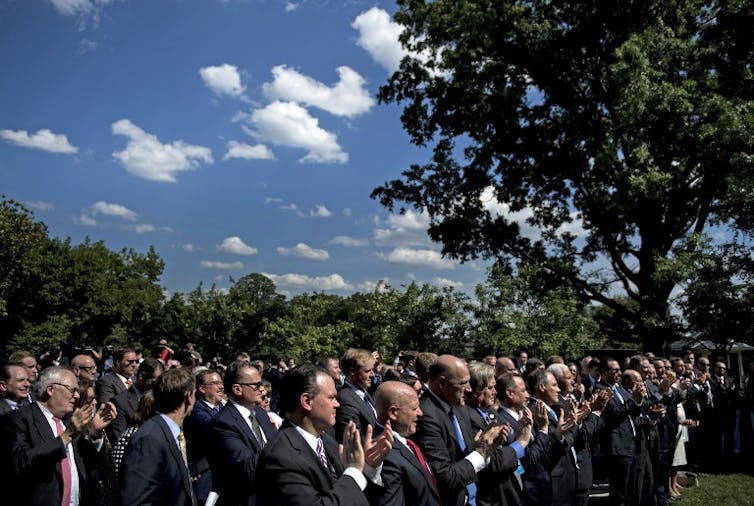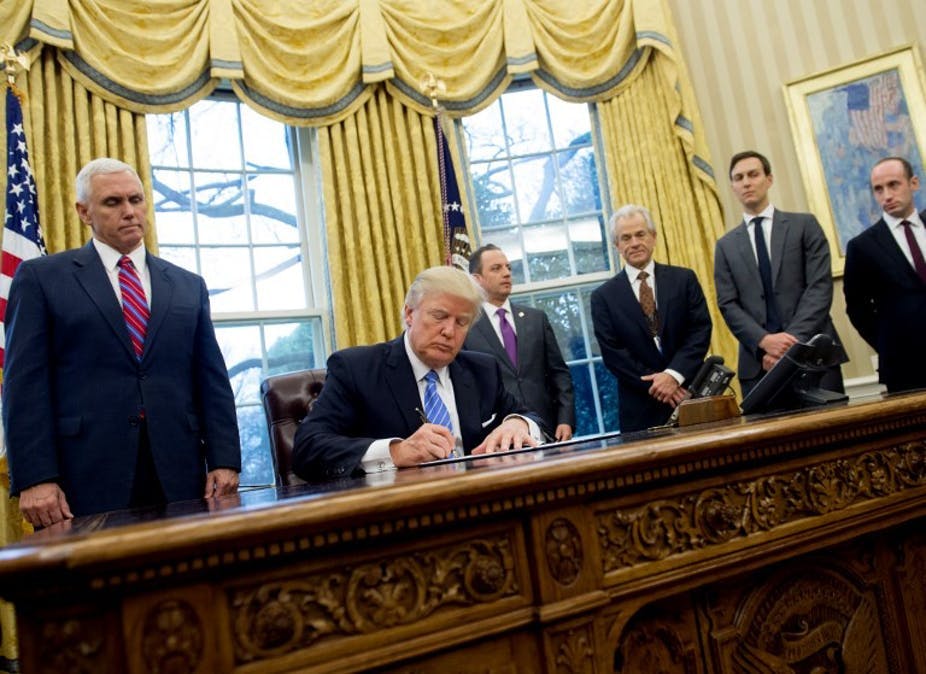Above these words you can see a January 2017 picture of the US President, Donald Trump, signing one of his first presidential decrees. It reinstated the global “gag rule” forbidding US funding for international NGOs supporting abortion in any way, directly or indirectly. The decree applies to contraception as well.
Below is another photo, taken on June 1 the same year, on the lawn of the White House on the occasion of the announcement by Trump that he would withdraw from the COP21 Paris Accord on climate change. The picture was taken in front of an audience that was both selected and representative.

These two photos show several characteristics of the political agenda of the Trump administration that appear to be a perfect expression of dominant masculinity:
-
The absence of women in both the staff and the audience.
Those present are almost entirely white men whose average age is likely to be above 55.
The majority of those attending wear two-piece, grey suits.
Male domination and ownership of women’s bodies
Beyond the intentional curation with regard to gender (no women), race (no non-white individuals), social class (no blue-collar workers) and age (no young people), these pictures show two additional codes of virility.
First, there is a total absence of emotion – the faces are closed and stern. The few visible smiles appear to be the result of poorly controlled emotions. Second, the masculinity is structured in the quasi-military way, with strict alignments in the audience on the lawn of the White House and in the Oval Office.
Such solemn affirmations of male domination also refer to appropriation schemes that are easily recognisable – in particular, of women’s bodies and on nature.
Indeed, the first picture shows the fully assumed display of a political-ideological structure designed restrict women’s rights. In a rather cynical way, it’s a staging of the claim of ownership over women’s bodies and the affirmation of men’s right to use them as they wish. Such a staging is a provocative remake of the archaic patriarchal model: the biological characteristics that allow women to give birth are reversed into the obligation to give birth, even against their will.
Over human history, this obligation has been used to deprive women of rights over their own bodies as well as the foetus they may carry. Just when women and their reproductive rights are at the centre of legal and media controversies, they become invisible and disappear from the picture, literally.
Nature as both a dominated and unlimited resource
The President’s announcement he would seek to withdrawal the United States from the Paris Accord on Climate was full of nationalist rhetoric and not supported by the facts. In addition, it broke with 20 years of international negotiations that have contributed to a global awareness on the importance of fighting climate change. By their actions, Trump, his aides, supporters and followers reaffirmed a traditional view of man’s ownership of nature and his right to unlimited exploitation. This has been expressed in two opposing ways since the 17th century:
Positively by René Descartes:
“But as soon as I had acquired some general notions respecting physics, and beginning to make trial of them in various particular difficulties, had observed how far they can carry us, and how much they differ from the principles that have been employed up to the present time, I believed that I could not keep them concealed without sinning grievously against the law by which we are bound to promote, as far as in us lies, the general good of mankind. For by them I perceived it to be possible to arrive at knowledge highly useful in life; and in room of the speculative philosophy usually taught in the schools, to discover a practical, by means of which, knowing the force and action of fire, water, air the stars, the heavens, and all the other bodies that surround us, as distinctly as we know the various crafts of our artisans, we might also apply them in the same way to all the uses to which they are adapted, and thus render ourselves the lords and possessors of nature.”
Critically by Baruch Spinoza:
“Most writers on the emotions and on human conduct seem to be treating rather of matters outside nature than of natural phenomena following nature’s general laws. They appear to conceive man to be situated in nature as a kingdom within a kingdom: for they believe that he disturbs rather than follows nature’s order, that he has absolute control over his actions, and that he is determined solely by himself.”
The two photos are thus an arrogant expression of an outdated anthropological and ecological model that appears to be more and more discredited.
From an anthropological point of view, gender equality and the recognition of the universality of human rights, including sexual and reproductive rights, are both conceivable and part of an effective transformative agenda. From an ecological point of view, the ravages and devastations caused by pitiless competition, rampant consumerism, growth-at-all-costs thinking and unsustainable consumption of non-renewable natural resources have left little space for our learning to collectively and wisely manage them.

The perspective of sustainable and gender-sensitive development
As early as 1987, a report of the World Commission on Environment and Development, “Our Common Future” highlighted the linkages between the three pillars of sustainable development – social, economic and ecological – required to “meet the needs of the present without compromising the ability of future generations to meet their own needs.” The approach presented was based on a critical analysis of geographical inequality (north/south), as well as anthropological (women/men), demographic (current generation/future generations) and social (rich/poor).
All this assumes the creation and reinforcement of an innovative institutional architecture at the global level. As the expression of a collective political will aiming at overcoming the obsolescence of the current anthropological and ecological status quo, such an architecture could produce new international norms, representations and behaviours.
Donald Trump and all people who share his views and positions refuse to engage into such a process. In that way, they demonstrate the legitimacy and the urgency of a new approach that combines gender equality and environmental sustainability.


